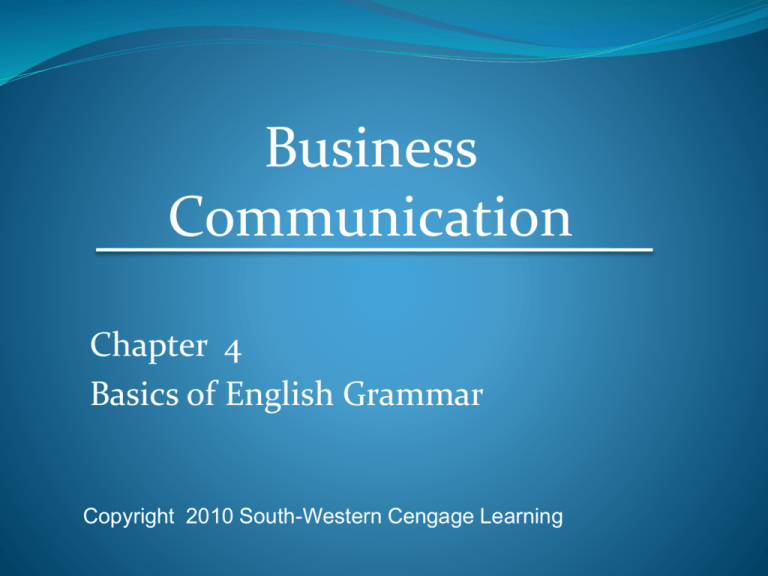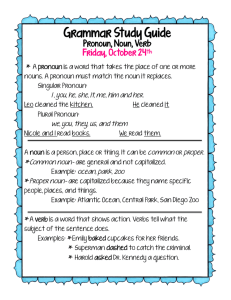noun
advertisement

Business Communication Chapter 4 Basics of English Grammar Copyright 2010 South-Western Cengage Learning Nouns A noun is a word used to name people, places, or things. 2 Proper Noun A proper noun names a specific person, place, or thing. Always distinguished by capital letters. Examples: Mary Ann, Seattle, Pepsi 3 Common Noun A common noun is a word that identifies a person, place, or thing in a general way. Examples: girl team rock car 4 Compound Nouns A compound noun is two or more common nouns put together. Examples: Editor in chief Son-in-law Board of directors Pocketbook 5 Singular Noun A singular noun is one that refers to one person, place, or thing. Some nouns are always singular: Advice Information 6 Plural Noun A plural noun is one that refers to more than one person, place, or thing. Can be formed by adding s to the end of the singular form: books guys Can be formed by adding es to a singular noun that ends in s, x, z, sh, ch, or o: lenses, bushes, taxes, potatoes 7 Plural Noun Can be formed by changing a y at the end of the word to an I and then adding es: cities, territories Can be irregular plural forms: man to men; child to children; foot to feet Some nouns are always plural Pants Goods 8 Collective Noun A collective noun represents a group that usually acts as a single unit. Examples: Tribe Jury 9 Possessive Nouns Possessive nouns are ones that show ownership. Examples: man Ms. Lopez Executives Attorneys +’s +’s +’ +’ = = = = man’s opinion Ms. Lopez’s car executives’ attorneys’ 10 Pronouns Pronouns are words used in the place of nouns. 11 Personal Pronoun A personal pronoun is a substitute for a noun that refers to a specific person or thing. May be in the Nominative case Objective case Possessive case 12 Nominative Case Pronoun A nominative case pronoun may be used a s a subject or a predicate nominative in a sentence. Examples: I We You He She It 13 Objective Case Pronoun An objective case pronoun may be used as a direct or indirect object of a verb or as the object of a preposition. Examples: Me Us You Him Her 14 Possessive Case Pronoun A pronoun that indicates ownership is a possessive case pronoun. Examples: My Mine Our Your His Her 15 Examples: Nominative Case Anita and I voted for him. It is she who received all the attention. Objective Case Please send them by express mail. Lamar brought her a burrito. Possessive Case These are our folders. The fancy clothes are hers. 16 Intensive Pronouns An intensive pronoun is a compound pronoun created by joining a pronoun with self or selves. Examples: Myself Yourself Ourselves Themselves 17 Reflexive Pronoun A reflexive pronoun is also a compound pronoun that ends in self or selves; however, it refers to a noun or pronoun that appears earlier in a sentence. Example: We found ourselves reminiscing at the reunion. 18 Interrogative Pronoun An interrogative pronoun begins a question that leads to a noun or pronoun response. Examples: Who Whose Whom Which What 19 Demonstrative Pronoun A demonstrative pronoun is used to point to a specific person, place, or thing. Examples: This That These Those 20 Pronoun-Antecedent Agreement The noun or noun phrase that is replaced or referred to by the pronoun is called the pronoun antecedent. 21 First-Person Pronoun Use a first-person pronoun to represent the persons speaking Examples: I we 22 Second-Person Pronoun Use a second-person pronoun to represent the persons spoken to Example: you 23 Third-Person Pronoun Use a third-person pronoun to represent the persons spoken about Examples: He She It They 24 Examples Antecedents and Pronouns Kim encouraged his staff. Anyone can state his or her opinion on the matter. A good manager consults with his or her staff. The panel submitted its report. The students completed their software installation on time. 25 Compound Antecedents A compound antecedent is one that consists of two or more elements. Examples: After Shawn and I drafted the proposal, we sent it to Ms. Jones. After Joe and Robert played ball, they went home. Maria and Yuki practiced their songs for the play. 26 Indefinite Pronoun Agreement An indefinite pronoun refers in general terms to people, places, and things. Examples: One Each Every Many Few Both 27 Adjectives An adjective is a word that describes or limits nouns, pronouns, and phrases that act as nouns. Adjectives answer questions about nouns Which one? This proposal, those appointments How many? Six calls, few tourists What kind? Ambitious student, creative teacher 28 Articles The Denotes a specific noun or pronoun The man A A man An Denotes a nonspecific noun or pronoun An honorable leader 29 Nouns and Pronouns Used as Adjectives Nouns or pronouns that precede and modify other nouns and answer questions are used as adjectives. Examples: Luis had four theater tickets. Our family thoroughly enjoys Thanksgiving dinner. 30 Compound Adjectives A compound adjective is two or more hyphenated words that precede and modify nouns. Examples: The well-known mystery writer is signing copies of his book. Vivian is selling long-term service plans. Mrs. Woo will attend a high-level meeting. 31 Comparison of Adjectives Regular adjectives have three degrees of comparison: The positive degree Describes one item The comparative degree Describes two items The superlative degree Describes three or more items 32 Positive Degree The box is a big carton. Montel is an efficient worker. He is as big as you. 33 Comparative Degree The box is a bigger carton than the first one. Montel is less efficient than Charles. 34 Superlative Degree The box is the biggest carton of the three. Montel is the least efficient of the new employees. He is the biggest boy in his class. 35 Absolute Adjectives Absolute adjectives cannot be compared because they do not have degrees. Examples: Immaculate Perfect Square Round Complete 36






